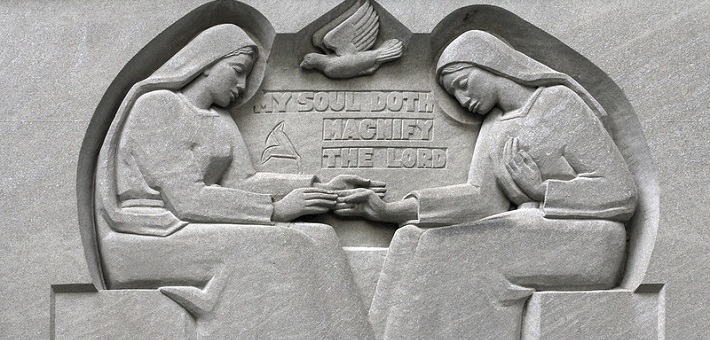Commentary on Micah 5:2-5a
As I read Micah 5:2-5a, the Christmas carol “O Little Town of Bethlehem” comes to mind. The lyrics, written by Phillips Brooks in 1868, were inspired by his nighttime visit on horseback in 1865 to the village of Bethlehem. Although the poem draws primarily on Luke’s story of Jesus’ birth and Brooks’s own experience, it also resonates with Micah 5:2-5. A birth in Bethlehem, the “hopes and fears of all the years,” and the joyful proclamation of peace to all the earth—all have their roots in this lectionary reading.
Yet these familiar associations run the risk of smoothing out the rough edges of the fears which Micah 5:2-5 seeks to address. What would happen if we reconsider this text in our present circumstances, during a long-drawn-out pandemic in which it often seems that our fears have only multiplied? Mindful of our own fears, how would we understand this text as a response to fears of a different time and place?1 As we prepare for our own visit to Bethlehem on Christmas day, how can this text direct our focus to that ancient time and place?
The eighth-century prophet Micah famously prophesied that “Zion would be plowed as a field; Jerusalem shall be a heap of ruins” (Micah 3:12). Today’s lectionary reading presupposes the fulfillment of that prophecy in Nebuchadnezzar’s siege and destruction of Jerusalem in 588-586 BCE. That siege is graphically presented in a series of poems in Micah 4, all of which begin with the adverb “now”: Now Zion cries aloud (4:9); now enemy nations assemble against her (4:11); now she is hemmed in (5:1). These poetic units chart Jerusalem’s mounting terror as the siege closes in on her; they also attribute the city’s inevitable destruction to the failures of its leaders. “Is there no king in you? Has your counselor perished, that pangs have seized you like a woman in labor?” (Micah 4:9).
Jerusalem’s helplessness is made complete when even the king is publicly humiliated: “with a rod they strike the ruler of Israel upon the cheek” (Micah 5:1 compare 2 Kgs 25:4-7). Jerusalem, by long tradition regarded as YHWH’s dwelling place and therefore a place of safety and refuge, has become a cauldron of disaster from which there is no escape. Even worse, Jerusalem can no longer expect help from its leaders, who have either abandoned the city or suffered humiliating assault themselves.
Over against Zion’s unendurable present reality, Micah envisions a new future by shifting the gaze to a different place and an ancient time. Addressing the town of Bethlehem, God announces the coming of a new ruler “whose origin is from old, from ancient days” (Micah 5:2). In the geography of Israel’s memory, Bethlehem was where David came from. According to 1 Samuel 17:12, David was the youngest son of Jesse, a member of the clan of Ephrathah of Bethlehem. The reference in Micah 5:2 to Ephrathah’s smallness may indicate the military insignificance of this clan.2 That the ruler would come from this town and not from the royal city of Jerusalem reflects the biblical theme of God’s unexpected choice of the younger over the older, the defense of the weak against the strong.
Samuel’s anointing of Jesse’s youngest son David exemplifies this theme. It is an open question whether the poem intended to allude to David as the “once and future king.”3 Many scholars see implicit allusions to David, but the fact that he is never mentioned by name leads Daniel Smith-Christopher to suggest that the text implies a complete rejection of David to start all over again, possibly with another of Jesse’s sons.4 In my view, the logic of Micah’s contrast between Jerusalem’s miserable present circumstances and a glorious new future rooted in ancient times requires us to imagine a known figure. In Zion’s desperate present circumstances, new experiments will not suffice.
Micah’s vision of a future rooted in the past gives shape and meaning to Zion’s present suffering. Alluding to Micah 4:9, in which the absence of a king leaves Zion writhing in pain like a woman in labor, Micah 5:3 suggests that Zion’s suffering will end, as all labor does, in childbirth. Unlike Isaiah 7:14, which speaks of the birth of a specific person (for example, Isaiah 7:14), the reference to childbirth in Micah 5:3 is metaphorical. But, like the broader context of Isaiah 7, the figure of labor ending in childbirth is intended to suggest a limited period of time. For the present moment, God has consigned Zion to suffering; but even this travail will come to an end.
The imagery of childbirth also signifies the dawning of a new era, which undoes the leaderless helplessness of Zion’s past. In contrast to Zion’s humiliated ruler and absent counselors, the new ruler “stands and feeds his flock in the strength of the Lord” (Micah 5:4). Not only does the imagery of shepherding evoke memories of David’s humble origins, it also exemplifies the traits of the ideal ruler. In the ancient world, shepherding was a significant metaphor of kingship, which indicated that the king’s proper role was to care for and defend his subjects. Under this new ruler’s care, families are reunited as “brothers” return from exile (verse 3) and settle on the land in security (verse 4).
The reign of such a one is summarized in the final line, “and he shall be the one of peace” (Micah 5:5a). This line can be translated to emphasize either the ruler (NRSV: “he shall be the one of peace”) or the result of his reign (“He shall bring about peace”). It is open-ended in other ways as well: Does peace consist primarily in domestic security, as suggested by the lectionary text? Or does it extend to victory over Israel’s enemies, as indicated by Micah 5:5b-6? Beyond the context of Micah, reinterpretations yield other possibilities. For example, in Ephesians 2:14, one finds an echo of Micah 5:5a in the identification of Christ as “our peace,” who breaks down the dividing wall of hostility between Jew and Greek. However this peace is understood, it is ultimately rooted in the ruler’s service to YHWH, who claims him as his own.
In the face of the utter failure of Judah’s kings and Zion’s certain destruction, Micah returns to Bethlehem to reclaim an ancient model of leadership as care. Emerging in an obscure town from an insignificant clan of Judah, this shepherd-ruler claims no strength of his own but rather rules in the power of God and in ways that make for peace. In Micah, the existential threats were military and political, and as we consider Micah 5:2-5a in its broader literary context, we readily see that the book envisions peace as military victory over Israel’s political oppressors (see especially, Micah 5:5b-6).5
As Luke tells the story of the birth of a new king, he also must deal with the gritty reality of political and military power. Even in the relatively peaceful story of Jesus’ birth, Rome controls the lives of all Judeans as it requires them to be registered. At the end of the gospel, Rome will claim power over Life itself as it crucifies God’s messiah. Yet, for a brief moment, a birth in Bethlehem draws our attention to an utterly new possibility of a different kind of reign. Angels give glory to God and declare the possibility of a new kind of peace.
In a more idyllic time when Bethlehem was not disputed political territory as it is today6, Phillips Brooks encountered Bethlehem as a still point on the horizon of the “hopes and fears of all the years.” As we muddle our way through the innumerable fears of our time, Luke and Micah beckon us to gaze on Bethlehem once again, where once again we find the king who is our peace.
Notes
- Ehud Ben Zvi, Micah (FOTL XXIB; Grand Rapids, MI: William B. Eerdmans, 2000), 88. Other commentaries consulted for this essay include Hans Walter Wolff, Micah: A Commentary, translated by Gary Stansell (Minneapolis: Augsburg, 1990); and Daniel L. Smith-Christopher, Micah: A Commentary (OTL; Louisville, KY: Westminster John Knox Press, 2015).
- Smith-Christopher, Micah, 165.
- The allusion is to T. H. White’s Once and Future King (1958), a study of the legends of King Arthur.
- Smith-Christopher, Micah, 167.
- Ben Zvi, Micah, 129-130.
- https://en.wikipedia.org/wiki/Bethlehem. Accessed September 30, 2021.


December 19, 2021